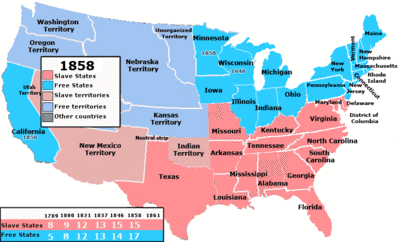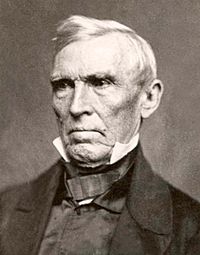Crittenden Compromise facts for kids
The Crittenden Compromise was a plan suggested in 1860 to try and stop the American Civil War from happening. It was an attempt to keep the United States together by making sure slavery would always be allowed in states where it already existed. This plan was introduced by Senator John J. Crittenden from Kentucky.
The main goal was to calm the fears of the Southern states, who were worried that the government would try to end slavery everywhere. The compromise aimed to protect slavery in the Constitution itself, making it very hard to get rid of in the future. It's important not to confuse this with the Crittenden–Johnson Resolution, which was a different proposal about the war's goals.
Contents
Why the Compromise Was Needed
By late 1860, the United States was in a big crisis. Several Southern states were threatening to leave the Union because they feared that the new President-elect, Abraham Lincoln, and his Republican Party would try to end slavery. Senator Crittenden's plan was a last-minute effort to find a way for the North and South to agree and avoid war.
The compromise included six proposed changes to the Constitution and four resolutions for Congress to pass. Crittenden presented his ideas on December 18, 1860.
The plan promised that slavery would continue in the states where it was already legal. It also tried to solve problems related to fugitive slave laws and slavery in places like Washington, D.C.. A key part of the plan was to bring back the Missouri Compromise line of 36° 30′. This line would divide new territories: slavery would be banned north of the line, but allowed and protected south of it. The compromise also said that these new rules about slavery could never be changed later.
Many Southern senators liked the idea. However, the Republicans, led by Abraham Lincoln, were against it. They did not want slavery to spread into any new territories. Lincoln believed that allowing slavery to expand would lead to more conflict.
What the Compromise Proposed
Changes to the Constitution

The compromise suggested six permanent changes to the Constitution:
- Slavery would be banned in any new territory north of the 36° 30′ line. But south of this line, slavery would be allowed and protected by the government. When these territories became states, they could decide for themselves if they wanted slavery or not.
- Congress would not be allowed to end slavery in places it controlled, like military bases, if those places were inside a slave state.
- Congress could not end slavery in Washington, D.C. unless the nearby states of Virginia and Maryland also ended it, and the people in D.C. agreed. If slavery was ended, slave owners would be paid for their slaves.
- Congress could not stop the trade of slaves between different states.
- If an escaped slave was rescued and not returned to their owner, Congress would pay the owner. Congress could then try to get the money back from the county where the rescue happened.
- No future change to the Constitution could ever undo these amendments or give Congress the power to interfere with slavery in slave states.
Congressional Resolutions
The compromise also included four resolutions for Congress:
- The fugitive slave laws, which required escaped slaves to be returned to their owners, were constitutional and should be followed.
- Any state laws that made it harder to return escaped slaves (called "Personal liberty laws") were against the Constitution and should be removed.
- The Fugitive Slave Act of 1850 should be changed to make it fairer. For example, the fees for returning or releasing alleged fugitives would be equal.
- Laws meant to stop the international African slave trade should be strictly enforced.
Why the Compromise Failed
President-elect Abraham Lincoln was strongly against the Crittenden Compromise. He believed that slavery should not be allowed to spread into new territories. Because of Lincoln's opposition and the Republican Party's stance, both the House of Representatives and the Senate voted against Crittenden's plan.
The Crittenden Compromise was one of the last attempts to find a peaceful solution before Lincoln became president. Another meeting, called the Peace Conference of 1861, also discussed these proposals. But again, the idea of protecting slavery in all new territories was not accepted.
The failure of the Crittenden Compromise showed that the North and South could not agree on the future of slavery. This disagreement eventually led to the start of the American Civil War.
In Popular Culture
The novel Underground Airlines (2016) by Ben Winters imagines a different world. In this story, the Crittenden Compromise was accepted after Abraham Lincoln was assassinated. In this alternate history, slavery continues into the 21st century in a few Southern states.


